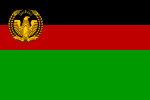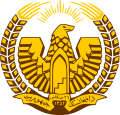Republic of Afghanistan
|
Dǝ Afġānistān Jumhūriyat (Pashtun) Jǝmhūri Afġānistān (Persian) جمهور افغانستان د افغانستان جمهوریت Republic of Afghanistan 1973–1978 |
|||||
|
|||||
|
|||||
| Motto : | |||||
| Official language |
Pashtun Persian |
||||
| Capital | Kabul | ||||
| Form of government | Presidential Republic | ||||
| Form of government | Authoritarian one-party system | ||||
|
Head of State and Government |
President Mohammed Daoud Khan | ||||
| surface | 647,500 km² (1978) | ||||
| Residents | 13,199,600 (1978) | ||||
| currency | Afghani | ||||
| founding | August 24, 1973 (abdication of the king) | ||||
| resolution | April 27, 1978 (Saur Revolution) | ||||
| National anthem | So Che Da Mezaka Asman Wi | ||||
| Time zone | UTC +4.5 (March to October) | ||||
| License Plate | AFG | ||||
| Telephone code | +93 | ||||
| map | |||||

|
|||||
The Republic of Afghanistan ( Persian جمهوری افغانستان Jumhūrī-ye Afġānistān , also known as the Daoud Republic ) was the successor to the overthrown Afghan monarchy, the Kingdom of Afghanistan . The republican system was the official state government of Mohammed Daoud Khan from 1973 to 1978.
Daoud Khan became Afghanistan's first president in 1973 after dethroning Mohammed Sahir Shah in a bloodless coup. Daoud is known for his progressive politics and his intentions to modernize the country with the help of the Soviet Union and the United States, among others .
In 1978 a military coup known as the Saur Revolution took place - instigated by the DVP of Afghanistan , which was too slow to modernize. Daoud and his entire family were lynched during the 1978 coup. The end of the Daoud Republic marked the birth of the Democratic Republic of Afghanistan (1978–1992).
founding
In 1973, when Mohammed Sahir Shah underwent eye surgery and lumbago therapy in Italy , his cousin and former Prime Minister Mohammed Daoud Khan staged a coup and established a republican government.
As a former prime minister, Mohammed Daoud Khan was forced to step down by Sahir Shah a decade earlier.
In August after this coup, Sahir Shah abdicated for fear of an all-out civil war.
Political reforms
In the same year, the former Prime Minister of Afghanistan, Mohammad Haschim Maiwandwal, was arrested for preparing a coup against the newly established Daoud government. The putschists wanted to transfer power from Daoud back to the former King Mohammed Sahir Shah. Maiwandwal was detained and died of suicide in prison before his trial; There is a widespread belief in Afghanistan that he was tortured to death.
After the coup, Mohammed Daoud Khan established his own political party, the National Revolutionary Party . This party became the sole center of political activity in the country. The Loja Jirga approved Daoud's new constitution, which in January 1977 established a one-party presidential system . Any resistance or revolt against the new regime was suppressed or suppressed by the government.
Gaining strength of communism
During Daoud's presidency, relations with the communist countries abroad, especially the Soviet Union , and with the Afghan communists in the country deteriorated . The Soviet Union viewed Daoud's transition to a more western-oriented leadership as dangerous, as Daoud tried to distance himself and Afghanistan from the neighboring state of the Soviet Union. He expelled the Soviet military and economic advisers and criticized Cuba's role within the movement of the non-aligned states . The Soviets increasingly saw Daoud's policies as an " anti-communist " concept due to his new approach to the People's Democratic Party of Afghanistan .
In 1976 Daoud drafted a seven-year economic plan for the country. For example, he began military training programs with India and began talks on economic support with Iran under Mohammad Reza Pahlavi . Daoud also turned his attention to oil-rich Middle Eastern nations such as Saudi Arabia , Iraq and Kuwait for financial assistance, among other things.
By 1978 Daoud had achieved little of what he set out to do. The Afghan economy had made no real progress and the Afghan standard of living had not increased. Daoud also came under heavy criticism for his one-party constitution from 1977, which alienated him from his political supporters. By this time, the Partscham and Chalq factions in the DVPA had reached a fragile agreement on reunification. And at that point, communist officials were planning a military coup against the Daoud government. According to the later second president of the Democratic Republic of Afghanistan , Hafizullah Amin , plans for the coup began in 1976, two years before the Saur Revolution .
On April 27, 1978, the Republic of Afghanistan came to an end with the acid revolution and was replaced by the Democratic Republic of Afghanistan .
Web links
Individual evidence
- ↑ Barnett Rubin: DĀWŪD KH AN . In: Ehsan Yarshater (ed.): Encyclopædia Iranica . Online ed.-. Columbia University , United States ( online [accessed May 11, 2013]).
- ↑ a b c d e f Daoud's Republic, July 1973 - April 1978. Country Studies , accessed March 15, 2009 .
- ↑ a b Barry Bearak: Former King of Afghanistan Dies at 92. The New York Times , July 23, 2007, accessed March 19, 2009 .

